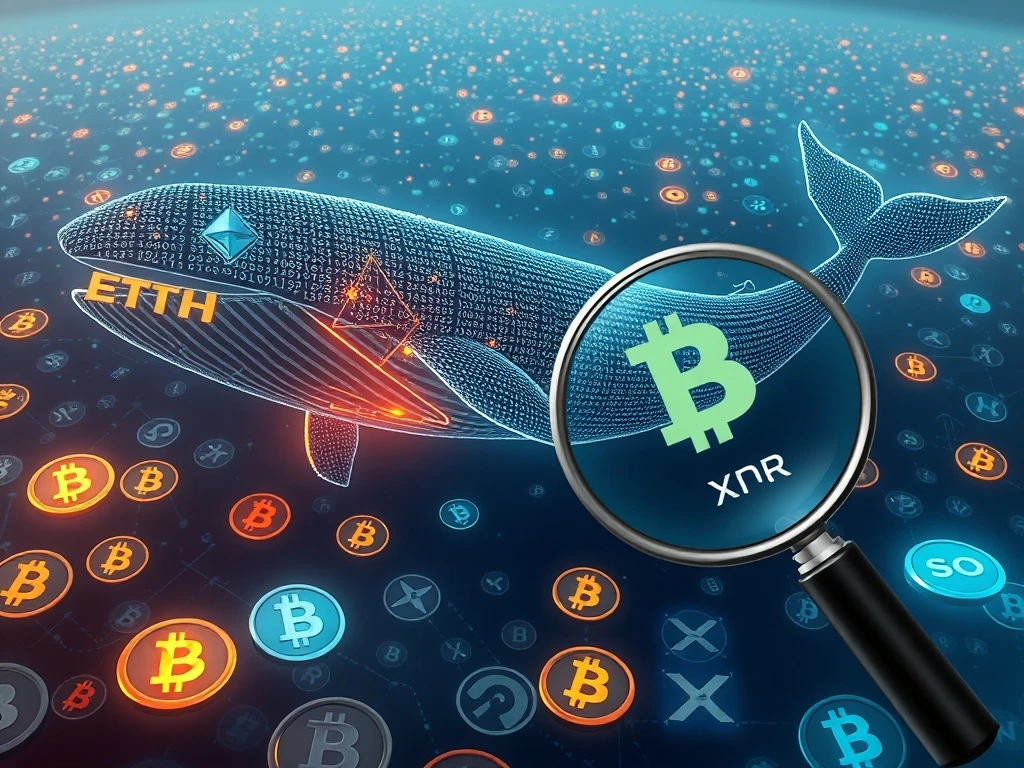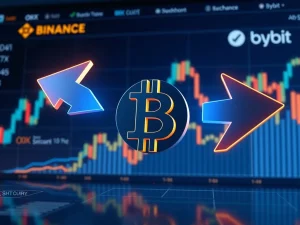Massive Ethereum Whale Moves Spark Altcoin Leverage Frenzy

The cryptocurrency market is a dynamic arena, often swayed by the colossal movements of its largest players – the crypto whales. Recently, these financial titans have made waves, mobilizing an astonishing $147.7 million in Ethereum (ETH) and an additional $11.37 million in USDC. These significant transactions aren’t just random acts; they signal a calculated shift towards an altcoin leverage spree, aiming to capitalize on short-term volatility and potentially reshape market dynamics. For anyone invested in the digital asset space, understanding these whale movements is crucial.
Decoding the Latest Crypto Whale Mobilization
In the past 24 hours, the crypto world has witnessed a flurry of activity from its wealthiest participants. These aren’t just small trades; we’re talking about multi-million dollar transactions that can send ripples across the entire market. The scale of these operations highlights a strategic play, often involving high-leverage positions and significant volume to influence price action.
- Massive ETH Inflow: A newly identified wallet received 38,603 ETH, valued at an astounding $147.7 million. This substantial transfer has been linked to previous movements from SharpLink Gaming, suggesting potential liquidity management or strategic accumulation in anticipation of future opportunities.
- USDC Fuels Altcoin Leverage: Over $11.37 million in USDC was deposited on HyperLiquid by various whales. This capital was immediately put to work, opening leveraged long and short positions on a diverse range of altcoins including XRP, SOL, and BONK. One particular whale even deployed 3x leverage on BNB and a staggering 20x on SOL, indicating a keen focus on capturing rapid price swings.
- Strategic Altcoin Shifts: Beyond the major players, smaller, yet significant, altcoin movements were observed. A newly created wallet withdrew 1.88 million SPX ($3.73 million) from Bybit. In a more speculative move, a FARTCOIN whale sold 1.71 million tokens ($2.28 million) for PUMP tokens, showcasing the high-risk, high-reward nature of meme coin trading.
The Allure of Altcoin Leverage: Why Whales Take the Risk?
Leverage trading amplifies both potential gains and losses, making it a powerful tool for experienced traders. For crypto whales, the allure of altcoin leverage lies in their ability to magnify returns on relatively smaller price movements. Given their substantial capital, even a small percentage gain on a highly leveraged position can translate into millions of dollars. This strategy is particularly effective in volatile altcoin markets where price swings are more pronounced than in more stable assets like Bitcoin or even Ethereum.
The choice of platforms like HyperLiquid underscores the growing sophistication of whale strategies. These platforms often offer deep liquidity and advanced trading tools, allowing whales to execute large orders with minimal slippage. Their actions suggest a belief that specific altcoins are poised for significant short-term volatility, offering prime opportunities for leveraged plays.
Impact on Market Dynamics: What Does This Mean for You?
When crypto whales make such significant moves, it inevitably impacts broader market dynamics. Their large-volume trades can create or amplify price movements, especially in less liquid altcoin markets. This can lead to rapid price appreciation or sudden sell-offs, depending on their positions.
Historically, whale activity in altcoins often precedes broader market trends. These investors are often privy to information or have the capital to exploit market inefficiencies before retail investors. The substantial Ethereum inflow, for instance, could signal accumulation in undervalued assets or preparation for large-scale DeFi opportunities, especially given SharpLink Gaming’s previous $145 million USDC transfer to centralized exchanges.
Navigating the Volatility: Actionable Insights for Retail Investors
While following whale signals might seem tempting, retail investors must exercise extreme caution. The strategies employed by whales are often complex and carry significant risks. Sudden exits by whales can trigger destabilizing sell-offs, leaving smaller investors vulnerable.
Here are some actionable insights:
- Analyze On-Chain Metrics: While specific project fundamentals are key, monitoring on-chain data for large transactions can provide early indicators of whale interest.
- Prioritize Project Fundamentals: Do not blindly follow whale signals. Instead, thoroughly research the underlying technology, team, use case, and tokenomics of any altcoin before investing.
- Understand Leverage Risks: If considering leveraged trading, understand the extreme risks involved. It is not suitable for all investors and can lead to rapid capital loss.
- Diversify Your Portfolio: Avoid putting all your eggs in one basket, especially in highly speculative altcoins. Diversification can mitigate risks.
- Stay Informed: Keep abreast of market news, regulatory developments, and macroeconomic factors that can influence crypto prices.
Analysts like Mete Demiralp note that whale-driven altcoin activity often coincides with Bitcoin’s consolidation phases, reflecting a shift in risk appetite among institutional players. This focus on ‘high-gamma’ assets – those capable of rapid price swings – aligns with historical patterns where whale participation in altcoins has coincided with periods of regulatory clarity and macroeconomic stability.
The Speculative Side: Meme Coins and Market Liquidity
The mention of tokens like FARTCOIN and PUMP highlights the highly speculative nature of the meme coin market. While these tokens often lack fundamental utility, large positions can create temporary liquidity spikes and attract significant attention. The FARTCOIN-to-PUMP swap, for instance, underscores how large players can influence even the most niche segments of the crypto market, often driven by pure speculation rather than intrinsic value.
As trading volumes surge on major platforms, the interplay between whale activity and overall market liquidity becomes increasingly critical to monitor. While these reports don’t forecast specific price targets, they align with broader trends where altcoins have historically outperformed Bitcoin during periods of bullish sentiment. However, without fundamental support, whale-driven momentum can reverse quickly, particularly in low-cap tokens.
Conclusion: Navigating the Whale-Driven Tides
The recent mobilization of significant Ethereum and USDC by crypto whales signals a renewed focus on altcoin leverage and short-term trading opportunities. These powerful players are actively shaping market dynamics, leveraging substantial capital to capitalize on volatility. While their moves can be a precursor to broader trends, retail investors must approach such signals with a critical eye, prioritizing thorough research and risk management over impulsive decisions. The crypto market remains a high-stakes environment, and understanding the actions of its largest participants is key to navigating its ever-changing tides successfully.
Frequently Asked Questions (FAQs)
Q1: What is a crypto whale?
A crypto whale is an individual or entity that holds a very large amount of cryptocurrency, enough to potentially influence market prices through their trades. Their actions are closely watched by other investors.
Q2: Why are crypto whales mobilizing large amounts of Ethereum and USDC?
Whales mobilize large sums like Ethereum and USDC to either accumulate more assets, prepare for large-scale DeFi opportunities, or engage in high-leverage trading on altcoins to profit from short-term price volatility.
Q3: What does ‘altcoin leverage spree’ mean?
An ‘altcoin leverage spree’ refers to crypto whales using borrowed funds to amplify their trading positions in altcoins (any cryptocurrency other than Bitcoin). This strategy aims to magnify potential returns, but it also significantly increases risk.
Q4: How do whale movements affect market dynamics?
Whale movements can significantly impact market dynamics by creating large buy or sell pressures, leading to rapid price changes, especially in less liquid altcoin markets. Their actions can influence market sentiment and signal potential upcoming trends.
Q5: Should retail investors follow whale signals?
While whale signals can be informative, retail investors should exercise caution and not blindly follow them. Whales have different risk appetites, strategies, and capital. It’s crucial for retail investors to conduct their own research, understand project fundamentals, and manage their risks appropriately.
Q6: What are some of the altcoins mentioned in the recent whale activity?
Recent whale activity involved altcoins such as SPX, BNB, SOL, XRP, BONK, FARTCOIN, and PUMP, among others. These range from established major altcoins to highly speculative meme tokens.










